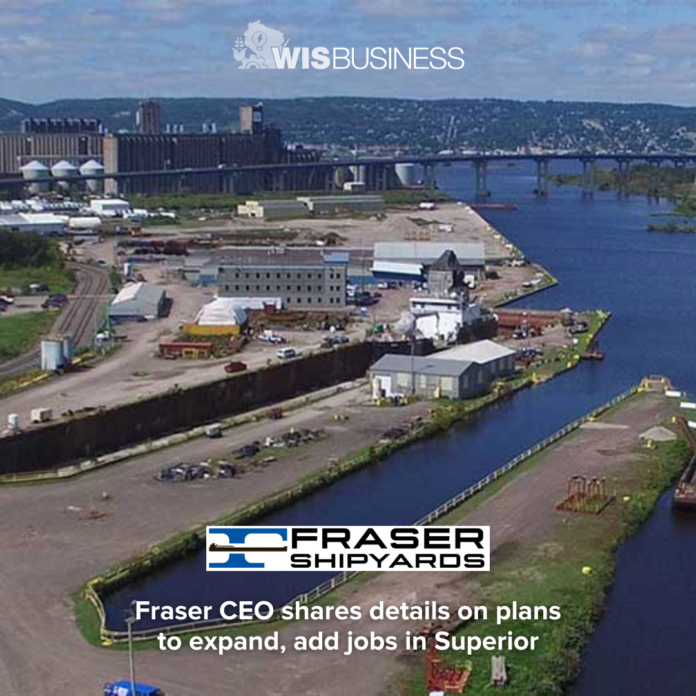Fraser Industries CEO Patrick Kelly projects his company will more than double its gross revenue and add 100 employees by 2025 as the Superior commercial and military shipbuilder expands operations.
Kelly tells WisBusiness.com he’s using his past experience at companies such as Amoco and BP raising capital and then working for private equity firms turning dwindling companies into more profitable ventures. He expects to finalize all the remaining formalities to secure investments needed to expand the shipyard and other operations before the end of the year.
Fraser also projects its headcount in Superior will grow up to 375 from a little more than 200 in 2022 in order to meet demands, according to documents exclusively provided to WisBusiness.com.
“Today, we have over a three-year — up to a four-year — backlog of boats to be built,” Kelly said, using boats to define everything from commercial ships to 30 foot Lake Assault Boats. “And so this [expansion] recognizes that and says, as we build additional floor space, I fill it immediately.”
The 133-year-old private company has a 600-foot drydock and another 800-foot drdock in Superior, facilitating major repairs and shipbuilding projects that might otherwise need to take place on the West Coast or East Coast.
Fraser projects gross revenue to grow to $102.4 million by 2025 from $42.5 million reported in 2022.
Expanding train and rail operations while making Fraser a public port — opening up 7,500 square feet of dock space — are some of the ways Kelly and his partners are bringing in more business.
The company’s Superior shipyard previously only used about 15 acres of the 60-acre property. But that extra land is now generating revenue since Fraser opened up a cargo terminal, looked to add railroad spur lines and started doing rail repair and paint services.
“It’s about serving customers in any way that we can,” Kelly said. “And, you know, business is hard, growth is hard to achieve. It’s not easy, but when you have a customer knocking on the door, saying, ‘Hey, will you do this for me?’ That’s kind of the light bulb goes off and says, ‘Okay, there’s a business there. Let’s go after that.’”
Fraser is proposing to invest $20.7 million in rail-related areas such as cranes, new tooling and equipment, and expanded production lines. The company argues the investments would make it possible to more than double production capacity, improve operation reliability, and save time and costs.
More work for Fraser would also mean more work for all the Wisconsin-based suppliers the company contracts with, Kelly said, noting the company strives to work with local suppliers.
While many details about contractors are confidential to maintain national security, Fraser’s lobbyist John Jacobson told WisBusiness.com the company was able to start installing Fond du Lac-based Mercury Marine motors on some of its boats after other suppliers were unable to provide some engine components due to supply chain issues.
About 85 percent of the company’s revenue comes from commercial and government contracts to build new ships or maintain and repair existing ships. Fraser has contracts with every branch of the U.S. military — save for the U.S. Space Force — as well as the National Park Service, various state agencies, tribal nations and several private companies, among others.
Fraser delivered its 200th aluminum lake assault boat this year and has contracts to build U.S. Navy docking vessels, U.S. Navy dive boats, NATO medium patrol boats, the Madeline Island ferry and a custom ferry boat for the Beausoleil First Nations Tribe in Ontario, Canada, among other work.
Kelly also said he’s been pushing Congress to change federal law to allow the U.S. Navy to bring its smaller ships — not aircraft carriers or larger battleships — through the St. Lawrence Seaway to the Great Lakes for repairs and maintenance. That would boost the workload for Fraser and many other shipyards in the region.
Kelly said the seaway could handle the extra traffic too as it currently only sees about 50 percent of its capacity flowing through the channels. Allowing naval ships to repair on the interior lakes would reduce maintenance turnaround times, increase military readiness and the twin ports of Superior and Duluth could provide more than adequate sailor accommodations while repairs are underway, Kelly said.
“Let’s get a big Navy vessel in and put them up at Barker’s Island,” Kelly said. “I don’t know why we wouldn’t. Many parts of the year it’s available and could be great accommodations for our sailors. I’m sure the Duluth-Superior Harbor would welcome our armed forces with open arms. What a what a great addition to the neighborhood, so to speak.”
–By Adam Kelnhofer






